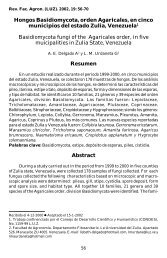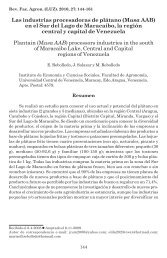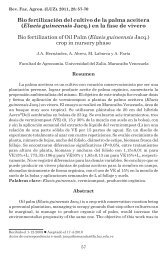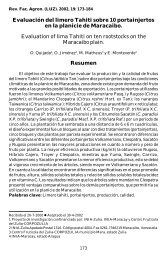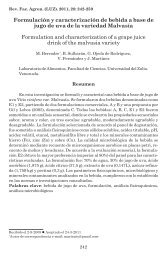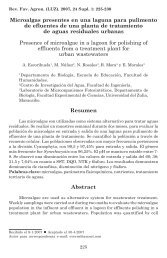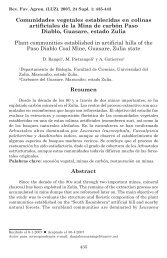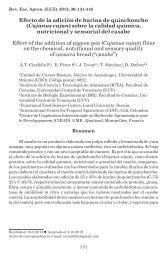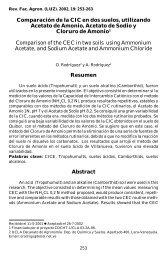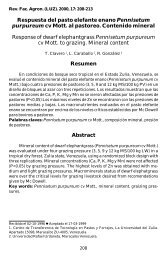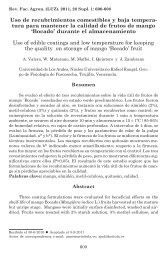Procesos productivos de la industria avÃcola zuliana - Revista de la ...
Procesos productivos de la industria avÃcola zuliana - Revista de la ...
Procesos productivos de la industria avÃcola zuliana - Revista de la ...
You also want an ePaper? Increase the reach of your titles
YUMPU automatically turns print PDFs into web optimized ePapers that Google loves.
Meleán-Romero et al.<br />
son numerosos y diversos, incluyen<br />
<strong>de</strong>s<strong>de</strong> <strong>la</strong>s progenitoras, pasando por<br />
el proceso <strong>de</strong> incubación, engor<strong>de</strong>,<br />
p<strong>la</strong>ntas <strong>de</strong> alimentos hasta el proceso<br />
mismo <strong>de</strong> beneficio, merca<strong>de</strong>o y<br />
comercialización. Todas estas etapas<br />
forman parte <strong>de</strong> <strong>la</strong> ca<strong>de</strong>na productiva<br />
<strong>de</strong> <strong>la</strong> <strong>industria</strong>; <strong>la</strong> cual busca coordinar<br />
e integrar cada uno <strong>de</strong> sus es<strong>la</strong>bones<br />
con el fin último <strong>de</strong> reducir costos,<br />
ser más productivas y hacerse<br />
competitivas en el mercado.<br />
Para lograr <strong>la</strong> competitividad en<br />
este sector <strong>de</strong> <strong>la</strong> economía, <strong>la</strong>s empresas<br />
avíco<strong>la</strong>s <strong>de</strong>berán encontrar formas<br />
para agregar continuamente valor a<br />
<strong>la</strong> producción y diferenciar sus productos;<br />
esto se constituye en un reto<br />
complejo dada <strong>la</strong> similitud productiva<br />
<strong>de</strong> <strong>la</strong> <strong>industria</strong>, a pesar <strong>de</strong> ser una<br />
vía para lograr el posicionamiento<br />
(Garcia 2007).<br />
Las empresas logran<br />
competitividad basándose fundamentalmente<br />
en <strong>la</strong> calidad y diferenciación<br />
<strong>de</strong> sus productos y con precios<br />
competitivos, para ello, <strong>de</strong>ben tener<br />
<strong>la</strong> capacidad <strong>de</strong> asumir estrategias<br />
empresariales, entre el<strong>la</strong>s, estrategias<br />
<strong>de</strong> co<strong>la</strong>boración como <strong>la</strong>s fusiones y<br />
alianzas; <strong>de</strong> integración vertical que<br />
permiten obtener economías <strong>de</strong> esca<strong>la</strong>s,<br />
producciones a gran volumen, con<br />
bajos costos y en tiempos competitivos;<br />
y estrategias enfocadas a <strong>la</strong> fuerza<br />
<strong>de</strong> trabajo, que por ser un recurso<br />
fundamental en este tipo <strong>de</strong> <strong>industria</strong>,<br />
requieren <strong>de</strong> entrenamiento y capacitación.<br />
En esta investigación, se analizaron<br />
los procesos <strong>productivos</strong> <strong>de</strong> <strong>la</strong>s<br />
fases <strong>de</strong> alimento, engor<strong>de</strong> y beneficio,<br />
consi<strong>de</strong>rando básicamente los factores<br />
<strong>productivos</strong>: tecnología o medios<br />
like fusions and alliances; of vertical<br />
integration that permit to obtain<br />
scales economies, productions at a<br />
high volume, with low costs and in<br />
competitives times; and strategies<br />
focused on <strong>la</strong>bor force, which by being<br />
a fundamental resource in this type<br />
of industry, training is required.<br />
In this research, the productive<br />
processes of feeding, fattening and<br />
s<strong>la</strong>ughter phases were analyzed by<br />
especially consi<strong>de</strong>ring the productive<br />
factors: technology or means or<br />
production and <strong>la</strong>bor force or hand<br />
<strong>la</strong>bor. Also, type of process in which<br />
each productive phase is framed<br />
because of being consi<strong>de</strong>red important<br />
for the study.<br />
• Production phases:<br />
feeding phase<br />
Production process of ba<strong>la</strong>nced<br />
feeding both fattening chicken and<br />
<strong>la</strong>yers and breeding hens in its<br />
different phases for other sectors, can<br />
be divi<strong>de</strong>d in seven stages (Chirinos<br />
2005): 1) Reception and storage of raw<br />
material, 2) Grinding, 3) Mixing, 4)<br />
Skinning, 5) Extrusion and screen, 6)<br />
Fatty adds, and 7) Pack and <strong>de</strong>livery<br />
in bulk.<br />
In this process, raw material are<br />
receipt, with a presentation that could<br />
be in sacks or in bulk, a sample is<br />
taken to guarantee quality control of<br />
inputs that begin process; after raw<br />
materials are grin<strong>de</strong>d and final<br />
particles of grinding process (flour or<br />
grains) are mixed by adding macro<br />
and micro ingredients besi<strong>de</strong>s of the<br />
liquid raw material indicated in formu<strong>la</strong>.<br />
These are managed by each<br />
enterprise <strong>de</strong>pending on feeding type<br />
and expected quality.<br />
Once obtained product in dust,<br />
170



